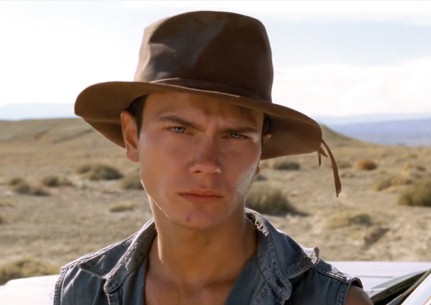
Dark Blood – Cry Me a River
River Phoenix gets an afterlife in Dark Blood, a modern western exhumed by the Eye Netherlands Film Institute. The moral tale, seen for the first time at the Berlin International Film Festival, is a polemic set on irradiated Indian land. It was shelved after Phoenix overdosed and died at the age of 23 in 1993 – and presumably after the company that insured the production paid out a huge settlement. The restored drama works best as a time capsule in tribute to the martyred youth.

Boy with Gun
Dark Blood is a melodrama – nothing if not politically correct. It’s missing some key scenes shot by director George Sluizer (The Vanishing, Utz) with DP Edward Lachman, both of whom limped slowly and uneasily onto the stage for a much-anticipated press conference in Berlin, where the film “premiered”” out of competition at the 2013 Berlinale.
Bear in mind that Dark Blood is 20 years old. In its bitterness toward thefts of Indian lands and the contamination of a vast region by nuclear tests, it evokes passionate causes of the early 1990’s, with a beatific lead whose short career aroused plenty of passion. Thanks to Lachman, the film looks a lot better than its script.
Dated now in its emotional rawness, the film has an anger that oozes out as unintentional humor — “I’ve got fucking plutonium dust all over me,” says Phoenix in one of his many moments of anguished honesty as a young man known simply as “Boy.”
That’s not the silliest utterance here, yet the encounter between a end-of-career Hollywood couple and youthful desert-dweller awaiting the apocalypse adds another chapter to Phoenix lore, and critics are sure to notice.
There’s a problem here if the distributors want to find a broad audience for Dark Blood. Most of those critics and Phoenix fans are over 40, and the youth audience isn’t rooted in the mythology of an ingenu who overdosed at 23. There are lots of those casualties to whom that public feels closer. For movie nerds, the film’s restoration story will fuel demand at festivals. If available in home video formats, Phoenix’s admirers will want to own it. Commercial release is unlikely, since the insurance company that paid out for the project made unreleasable by Phoenix’s passing might come looking for its money back.
Neither a masterpiece (albeit heretofore unseen) nor a breakthrough performance, Dark Blood is a curiosity, an unfinished work. Yet it’s the closest thing to a near-adult performance by Phoenix, a missing link boy idol between Johnny Depp and Leonardo DiCaprio – also the closest Phoenix parallel to James Dean’s Giant. Let’s not take any of these comparisons too literally.
It couldn’t have been more iconic, on paper. In Jim Barton’s script, a Bentley belonging to self-absorbed Hollywood actors Harry (Jonathan Pryce) and Buffy (Judy Davis) breaks down in the desert. The couple ignores advice and continues. When the car stalls again, they meet Boy (Phoenix), a callow widower, waiting for the end of the world, whose wife died of cancer caused by radiation from atomic tests. He’s in mourning, so every excess is forgiven.
Sluizer fills in the blanks by freezing the frame and reading stage directions and summarizing dialog in an accented deadpan — more mechanics than meta-narrative.
Harry is impatient to move on and Buffy is open to Boy’s clumsy and improbable flirtations – sex was still a new shade in Phoenix’s acting palette. In a desert house that looks borrowed from a Mad Max set, Harry and Boy argue. After an escape attempt and an interlude between Boy and Buffy, Harry kills Boy’s dog (named Dog – I’m not kidding). Boy becomes a martyr. Then, as we know, Phoenix martyred himself in an LA hotel.
The production was shot in southern Utah. Those were the days when, with the weight of Sundance, Utah led the way in attracting productions. Given the vast sky and stunning landscape, Sluizer directs Dark Blood like a three-hander stage play (The Petrified Forest?). His set is the house, a cabinet of curiosities filled with Kachina dolls that Boy carves and paints, plus a sexy photo of the once-stunning Buffy when she was younger. Lachman, a real asset to this picture, gave the cast and cutaway desert shots a vivid look – the near dust and dirt kicked up in fury, plus a faraway enclosure of peaks. He couldn’t save the script from the clichés of the time.
It’s tempting to view Phoenix as performing in a work-in-progress, only the progress ended so tragically. The young lean Phoenix tried to give his role a survivalist’s hard edge, as unlikely for the young man as Boy’s aggressive libido. His hat and loose clothing seemed a costuming tactic to give him the gaunt look of a migrant in John Ford’s classic The Grapes of Wrath (1940)– not that too many of Phoenix’s fans would notice. Boy’s wild child character blended frontier wisdom and delirium that a mature actor might have balanced. The boyish Phoenix (with the antithesis to the life-ravaged visage of his brother Joaquin) wasn’t ready for that challenge. When his fans see him in close-ups, they won’t mind. Somehow I imagine that this film will circulate widely in bootleg copies.
You won’t buy this dvd for the other roles. Not even a strong dose of radiation can explain the cartoonish Hollywood narcissism of Harry and Buffy. Stories from the shoot suggest that Davis was a horror on the set – if only her acting had any such verve. These silly caricatures, better left in the vault for Price or Davis, point to bitterness (on Sluizer’s part) toward the studios that the vain has-beens represent. Is there part of Dark Blood’s back-story that’s also missing?
Be prepared to see Dark Blood in Telluride. What better remote mountain setting for it? If not, maybe Sundance 2014 will pay tribute to the Utah production in situ.
